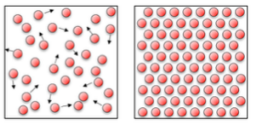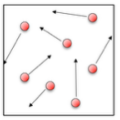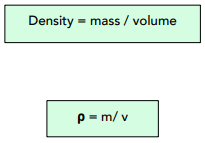Density (GCSE Physics)
Density
Density in Different States
Density in Solids and Liquids
The density varies in different states depending on how close together the particles are.
In solids and liquids, the atoms are quite close to each other. This means that the space between the atoms does not change much, so their density is quite high.
Liquids usually have a lower density than solids, as particles still have some room to move around. Ice and water are two exceptions, as they have a high density.

Density in Gases
Gases have much larger spaces between their particles. They have more energy to move, so the volume is able to increase much more. This means gases have a much lower density than solids or liquids.

Calculating Density
Density is a measure of how compact a substance is. It is a measure of how heavy an object is for its volume. We can calculate density using the following formula:

Where:
- density, ⍴, in kilograms per metre cubed, kg/m³
- mass, m, in kilograms, kg
- volume, V, in metres cubed, m³





Still got a question? Leave a comment
Leave a comment